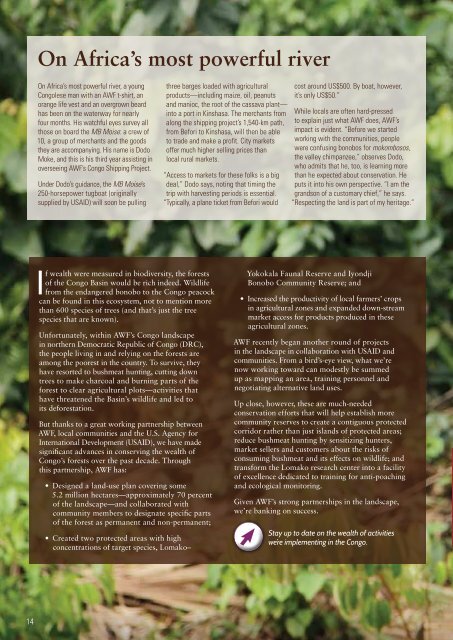awf-2014-report
awf-2014-report
awf-2014-report
Create successful ePaper yourself
Turn your PDF publications into a flip-book with our unique Google optimized e-Paper software.
On Africa’s most powerful river<br />
On Africa’s most powerful river, a young<br />
Congolese man with an AWF t-shirt, an<br />
orange life vest and an overgrown beard<br />
has been on the waterway for nearly<br />
four months. His watchful eyes survey all<br />
those on board the MB Moise: a crew of<br />
10, a group of merchants and the goods<br />
they are accompanying. His name is Dodo<br />
Moke, and this is his third year assisting in<br />
overseeing AWF’s Congo Shipping Project.<br />
Under Dodo’s guidance, the MB Moise’s<br />
250-horsepower tugboat (originally<br />
supplied by USAID) will soon be pulling<br />
three barges loaded with agricultural<br />
products—including maize, oil, peanuts<br />
and manioc, the root of the cassava plant—<br />
into a port in Kinshasa. The merchants from<br />
along the shipping project’s 1,540-km path,<br />
from Befori to Kinshasa, will then be able<br />
to trade and make a profit. City markets<br />
offer much higher selling prices than<br />
local rural markets.<br />
“Access to markets for these folks is a big<br />
deal,” Dodo says, noting that timing the<br />
trip with harvesting periods is essential.<br />
“Typically, a plane ticket from Befori would<br />
cost around US$500. By boat, however,<br />
it’s only US$50.”<br />
While locals are often hard-pressed<br />
to explain just what AWF does, AWF’s<br />
impact is evident. “Before we started<br />
working with the communities, people<br />
were confusing bonobos for mokombosos,<br />
the valley chimpanzee,” observes Dodo,<br />
who admits that he, too, is learning more<br />
than he expected about conservation. He<br />
puts it into his own perspective. “I am the<br />
grandson of a customary chief,” he says.<br />
“Respecting the land is part of my heritage.”<br />
If wealth were measured in biodiversity, the forests<br />
of the Congo Basin would be rich indeed. Wildlife<br />
from the endangered bonobo to the Congo peacock<br />
can be found in this ecosystem, not to mention more<br />
than 600 species of trees (and that’s just the tree<br />
species that are known).<br />
Unfortunately, within AWF’s Congo landscape<br />
in northern Democratic Republic of Congo (DRC),<br />
the people living in and relying on the forests are<br />
among the poorest in the country. To survive, they<br />
have resorted to bushmeat hunting, cutting down<br />
trees to make charcoal and burning parts of the<br />
forest to clear agricultural plots—activities that<br />
have threatened the Basin’s wildlife and led to<br />
its deforestation.<br />
But thanks to a great working partnership between<br />
AWF, local communities and the U.S. Agency for<br />
International Development (USAID), we have made<br />
significant advances in conserving the wealth of<br />
Congo’s forests over the past decade. Through<br />
this partnership, AWF has:<br />
• Designed a land-use plan covering some<br />
5.2 million hectares—approximately 70 percent<br />
of the landscape—and collaborated with<br />
community members to designate specific parts<br />
of the forest as permanent and non-permanent;<br />
• Created two protected areas with high<br />
concentrations of target species, Lomako–<br />
Yokokala Faunal Reserve and Iyondji<br />
Bonobo Community Reserve; and<br />
• Increased the productivity of local farmers’ crops<br />
in agricultural zones and expanded down-stream<br />
market access for products produced in these<br />
agricultural zones.<br />
AWF recently began another round of projects<br />
in the landscape in collaboration with USAID and<br />
communities. From a bird’s-eye view, what we’re<br />
now working toward can modestly be summed<br />
up as mapping an area, training personnel and<br />
negotiating alternative land uses.<br />
Up close, however, these are much-needed<br />
conservation efforts that will help establish more<br />
community reserves to create a contiguous protected<br />
corridor rather than just islands of protected areas;<br />
reduce bushmeat hunting by sensitizing hunters,<br />
market sellers and customers about the risks of<br />
consuming bushmeat and its effects on wildlife; and<br />
transform the Lomako research center into a facility<br />
of excellence dedicated to training for anti-poaching<br />
and ecological monitoring.<br />
Given AWF’s strong partnerships in the landscape,<br />
we’re banking on success.<br />
Stay up to date on the wealth of activities<br />
we’re implementing in the Congo.<br />
CONGO<br />
AWF partners with communities to save the natural resource–rich Congo Basin forest<br />
14<br />
With your support, AWF is finding ways to protect the<br />
forest while also ensuring people have secure livelihoods.<br />
15


